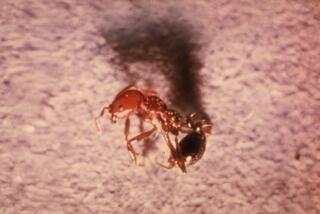Latest pest-control attempt: Turn fire ants into zombies
Texas may soon experience swarms of zombie fire ants, but that is a good thing. Really.
Turning the invasive ants into addle-brained wanderers is the latest attempt to control the non-native species, which has afflicted the South for half a century and causes an estimated $1 billion in damage in Texas each year. The insects swarm on circuit breakers and other electrical equipment, damaging them severely.
Swarms of the stinging insects can also severely injure humans and can kill smaller animals, such as calves and pets, that stumble across nests.
To combat the pest, Texas agricultural officials have begun releasing a new species of the antâs natural enemy, the South American phorid fly, Pseudacteon obtusus, Texas A&M; University said this week.
The fly attacks foraging fire ants, injecting eggs into the ant with a needle-like appendage. As the larvae mature, they attack and destroy the brain, causing the ant to wander aimlessly like a zombie. After two weeks or so, the antâs head falls off and a new fly emerges, ready to attack other ants.
The phorid flies have never been found to attack native ants, preferring to dine only on their South American hosts.
Scientists have previously released other species of phorid flies in Texas, but those species attack only ants in disturbed nests, and thus make only a minor contribution to controlling the invader. The new species is the first to attack foraging ants outside the nest.
The ants quickly become aware of the new flies and retreat into their nests, said entomologist Rob Plowes of the university. âItâs kind of like a medieval activity where you are putting a castle under siege,â he said. That retreat allows native ants better access to food sources, he added.
The flies will not eradicate the fire ants, Plowes added, but they could help control their spread.
--
More to Read
Sign up for Essential California
The most important California stories and recommendations in your inbox every morning.
You may occasionally receive promotional content from the Los Angeles Times.










